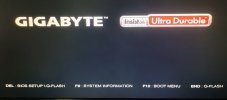Hi Experts.
I believe this question has been asked several time but I'm still not able to solve the problem with my PC desktop.
It's an old self assembly PC. The last time i upgraded the hardware was in early 2015, with the following configurations:
I upgrade the OS from Windows 7 to 10 two weeks ago to enable me to install plug-in Luminar AI.
Worked well for around one week, then the problem happen and continue until today, ie. my PC frequently crash / BSOD and then after re-boot stop at black screen "NTRDL is Missing". It happen several time a day after, after 1- 4 hours using my PC; even if I don't use it.
The BSOD error messages are not always similar. Could be:
I have to wait sometime (could be more than 1 hours) to press "Ctrl + alt Del" and then the PC will back to normal, though the problem happen again after 1 - 4 hours.
I've done few things such as memory test (Windows 10 memory diagnostic ), Chkdsk, Test all drive with CrystalDisk , Bitdefender system scan & vulnerability scan; all are good. Check and update all drivers. Check the temperatures - all good (35 - 42 C)
The problem does not disappear; in fact getting worst (more frequently and longer waiting time to reboot).
Very frustrating.
Thanks and appreciate for any advices and suggestions.
I believe this question has been asked several time but I'm still not able to solve the problem with my PC desktop.
It's an old self assembly PC. The last time i upgraded the hardware was in early 2015, with the following configurations:
- Intel(R) Core(TM) i7-4790 CPU @ 3.60GHz 3.60 GHz
- NVIDIA GeForce GT610
- 2 x 16 GB DDR3 1600
- C: Kingstone SV300S37A240G - For system and app. Free space more than 20%.
- D: DVD/CD-ROM Drive Asus DRW-24D3ST
- E: Hitachi HDT725050VLA380 (500 GB) - free space approx. 50
- F: ST2000DM008-2FR102 (1.8 TB) - free space approx. 60%
I upgrade the OS from Windows 7 to 10 two weeks ago to enable me to install plug-in Luminar AI.
Worked well for around one week, then the problem happen and continue until today, ie. my PC frequently crash / BSOD and then after re-boot stop at black screen "NTRDL is Missing". It happen several time a day after, after 1- 4 hours using my PC; even if I don't use it.
The BSOD error messages are not always similar. Could be:
- Critical process died
- System service exception
- Unexpected store exception
- Page Fault in nonpaged area
I have to wait sometime (could be more than 1 hours) to press "Ctrl + alt Del" and then the PC will back to normal, though the problem happen again after 1 - 4 hours.
I've done few things such as memory test (Windows 10 memory diagnostic ), Chkdsk, Test all drive with CrystalDisk , Bitdefender system scan & vulnerability scan; all are good. Check and update all drivers. Check the temperatures - all good (35 - 42 C)
The problem does not disappear; in fact getting worst (more frequently and longer waiting time to reboot).
Very frustrating.
Thanks and appreciate for any advices and suggestions.

